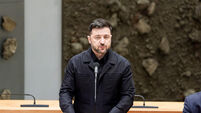Tsunami-hit area faces health catastrophe
Even as world leaders gathered today to co-ordinate billions of dollars in aid, doctors warned of a looming catastrophe from ever-more serious health woes - gangrenous wounds that require limb amputations, scores of children with diarrhea, pneumonia caused by exposure to dirty water.
The World Health Organisation said that if basic needs – particularly access to safe drinking water – are not restored by the end of this week, there would be a risk of infectious disease outbreaks that could kill 150,000 people – as many as the tsunami’s direct impact.
The first patients turning up at hospitals and makeshift clinics in Indonesia’s hard-hit Aceh province after the December 26 disaster had mostly scrapes, bruises and broken bones. Now, doctors say they are treating more serious problems.
Meanwhile, a 6.2-magnitude aftershock centred close to the provincial capital Banda Aceh shook the city after dawn today. Many residents panicked and fled into the streets fearing their homes might collapse, but there were no reports of fresh casualties.
Hundreds of quakes have rattled the region since December 26, but Thursday’s was among the strongest.
In Jakarta, world leaders were meeting to figure out the best way to spend nearly $4bn (€3bn) in aid that has been pledged worldwide.
Japan’s Prime Minister Junichiro Koizumi planned to offer Japanese technical expertise for an Indian Ocean tsunami warning system. The country has one of the world’s most advanced networks of fibre-optic sensors, which can warn of deadly tsunamis within two minutes of a quake.
UN Secretary-General Kofi Annan said the world was still trying to comprehend the magnitude of the catastrophe.
“Whole communities have disappeared,” he said. ”Millions in Asia, Africa, and even in far away countries, are suffering unimaginable trauma and psychological wounds that will take a long time to heal. Families have been torn apart.”
People in Thailand normally shun the help of mental health professionals.
But in the fishing village of Nam Khem in Phang Nga province – with 5,000 inhabitants – nearly every family lost members, said Dr. Taweesin Visanuyothin, director general of the Health Ministry’s Department of Mental Health. More than 2,000 have died or are missing.
Hundreds of people in the area have sought counselling to deal with anxiety, insomnia and flashbacks, he said.
In Aceh, dangerous infections were sneaking into superficial wounds, said Dr Ronald Waldman, who is co-ordinating WHO efforts in Indonesia. Measles has become a major threat, and UNICEF said it expects to start mass vaccinations in the area soon.
Pneumonia has also emerged as a significant illness, caused by exposure to dirty water during the tsunami, Waldman said.
But the number of cases of children with severe diarrhea is still low, and the cases are not thought to be due to the germs that cause cholera or other illnesses that could explode into epidemics, he said.
“Five million people have been severely affected by the tsunamis,” said WHO Director-General Dr Lee Jong-wook. ”We now estimate that as many as 150,000 people are at extreme risk, if a major disease outbreak in the affected areas occurs.”
Dozens of trucks were rumbling out of the airport at Banda Aceh, loaded down with drinking water, instant noodles and other aid. American helicopters clattered overhead rushing food to devastated villages on Sumatra’s west coast. Australian choppers were landing at the airport with scores of injured.
Around the city, aid workers, with masks covering their faces to try to ward off the stench of rotting corpses, were picking up bodies and dumping them in trucks to carry them to quickly-dug mass graves. Many of the bodies are being buried without being identified or counted.
On some houses are signs that read “There are bodies”, with arrows pointing to where corpses lay buried under rubble.













